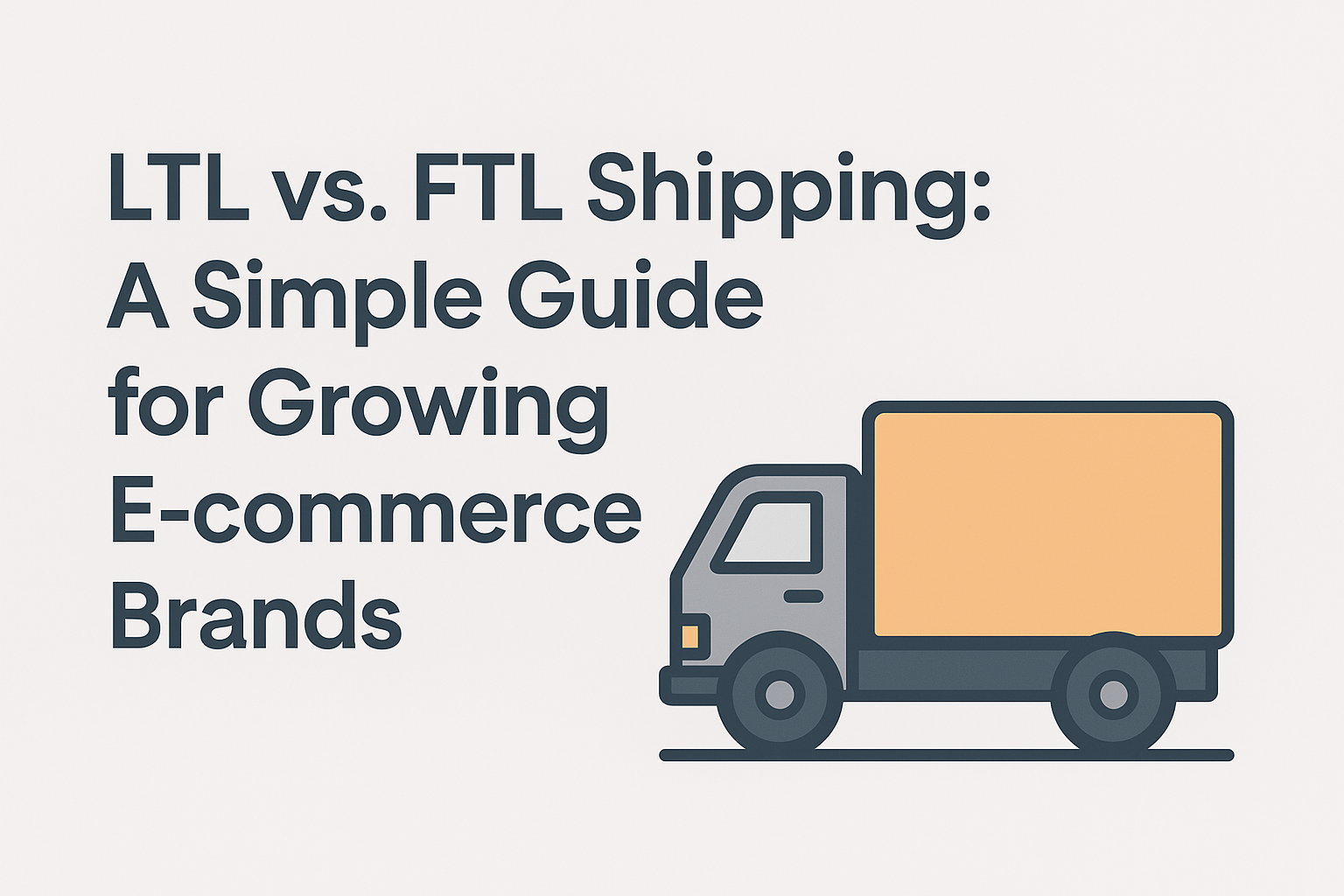LTL vs. FTL Shipping: Decoding Freight for E-commerce Efficiency
In the complex world of logistics, knowing how to efficiently move your products is just as crucial as the products themselves. For growing e-commerce brands, understanding the nuances of Less-Than-Truckload (LTL) and Full Truckload (FTL) shipping isn’t merely a detail; it’s a strategic imperative that directly impacts your costs, delivery times, and ultimately, your customer satisfaction. Many businesses, especially as they scale beyond small parcel shipments, find themselves at a crossroads: when to choose LTL, and when to go FTL?
The choice between LTL and FTL profoundly influences your operational efficiency, inventory management, and even your profitability. Making the right decision requires a clear understanding of what each method offers, their respective advantages and disadvantages, and how they integrate into a comprehensive fulfillment strategy. This guide will demystify LTL and FTL shipping, providing a detailed comparison, practical scenarios, and essential considerations to help your e-commerce brand navigate the freight landscape with confidence.
—
Understanding the Fundamentals: LTL vs. FTL Defined
Before diving into the strategic choices, let’s establish a clear definition of each shipping method.
What is Less-Than-Truckload (LTL) Shipping?
Less-Than-Truckload (LTL) shipping is a method used for transporting freight that does not require the entire space of a truck trailer. Instead, multiple shippers share space on the same truck, and they are charged based on the amount of space their freight occupies, its weight, and its classification.
- **Typical Volume:** Generally 1 to 10 pallets, or freight weighing between 150 lbs and 15,000 lbs.
- **Process:** LTL shipments are picked up from various origins, taken to a freight terminal, sorted, and then loaded onto another truck for delivery. This “hub-and-spoke” model means your freight will likely be handled multiple times and travel through several terminals before reaching its final destination.
What is Full Truckload (FTL) Shipping?
Full Truckload (FTL) shipping, as the name suggests, involves using the entire space of a truck trailer for a single shipment. The truck is dedicated solely to one shipper’s freight, moving directly from the origin to the destination without any stops or transfers at terminals.
- **Typical Volume:** Enough freight to fill or nearly fill a 48-foot or 53-foot trailer, or shipments exceeding 15,000 lbs.
- **Process:** The truck picks up the freight from one location and delivers it directly to the recipient. This method is ideal for large shipments, time-sensitive goods, or fragile items that require minimal handling.
—
The Core Differences: A Comparative Analysis
While both LTL and FTL move goods by truck, their operational characteristics, cost implications, and suitability for various e-commerce needs diverge significantly.
1. Cost Structure
| Factor | LTL Shipping | FTL Shipping |
|---|---|---|
| **Pricing Model** | Based on space used, weight, freight class, and distance. Shared costs among multiple shippers. | Flat rate for the entire truck, regardless of whether it’s fully utilized or not. |
| **Overall Cost** | Generally cheaper for smaller, less-than-full-truckload shipments. | More expensive per shipment, but potentially cheaper per pallet/unit for large volumes. |
| **Surcharges** | More prone to accessorial charges (e.g., liftgate service, re-delivery fees, limited access fees). | Fewer accessorial charges, as the entire truck is dedicated. |
For smaller bulk orders, LTL is cost-effective. For large, consistent shipments, FTL often offers a better unit cost. It’s crucial to calculate the actual cost per pallet or cubic foot to determine the most economical option for your specific volume.
2. Transit Time and Speed
- **LTL:** Generally slower. Due to the “hub-and-spoke” model, freight is handled multiple times, sorted, and potentially consolidated with other shipments. This adds transit time and introduces more variables. Expedited LTL services are available but come at a premium.
- **FTL:** Significantly faster. Direct point-to-point shipping means no intermediate stops or transfers. This makes FTL ideal for time-sensitive deliveries, especially for inventory replenishment at fulfillment centers or large B2B orders.
3. Security and Handling
- **LTL:** Increased risk of damage. Multiple transfers at terminals mean more handling by different crews, increasing the chance of mishandling. Proper packaging and palletizing are paramount to mitigate this risk.
- **FTL:** Lower risk of damage. Since the freight remains on a single truck from pickup to delivery, there is minimal handling once loaded. This makes FTL a safer choice for fragile, high-value, or sensitive goods.
4. Flexibility and Capacity
- **LTL:** Offers greater flexibility for smaller, irregular shipments. Easier to find available capacity for smaller loads.
- **FTL:** Requires booking an entire truck, which can be less flexible for very small, one-off shipments. Capacity can be tighter during peak seasons or for specific lanes.
—
When to Choose Which: Strategic Scenarios for E-commerce Brands
The “best” option isn’t fixed; it depends entirely on your specific needs, volume, and business model. Here are common scenarios where LTL or FTL shines:
Choose LTL When:
- **Volume is Moderate:** Your shipment is too large for parcel services but doesn’t fill an entire truck (e.g., 2-6 pallets).
- **Cost Savings are Key:** You prioritize lower shipping costs over the fastest transit time.
- **No Strict Deadlines:** Your delivery window allows for the potential variability of LTL transit times.
- **Replenishing Specific SKUs:** You need to send a limited quantity of particular products to a fulfillment center without filling an entire truck.
- **Local Deliveries:** Moving goods between regional distribution points or to a local wholesale client.
Choose FTL When:
- **Volume is High:** Your shipment is large enough to fill or nearly fill a truck (e.g., 10+ pallets).
- **Speed is Critical:** You have time-sensitive inventory (e.g., seasonal products, fast-moving consumer goods, promotional items) that needs to reach your warehouse or customer quickly.
- **High-Value or Fragile Goods:** You want to minimize handling and reduce the risk of damage for sensitive or expensive items.
- **Inventory Transfers:** Moving large quantities of inventory between your own warehouses or to a 3PL’s primary fulfillment center.
- **Direct B2B Shipments:** Fulfilling large wholesale orders directly to a retail distribution center or another business, especially when specific delivery windows are required.
—
The Role of Your 3PL in LTL & FTL Management
For growing e-commerce brands, navigating the complexities of LTL and FTL shipping can be daunting. This is where a strategic partnership with a reputable 3PL (Third-Party Logistics) provider becomes invaluable. A 3PL like WarehouseTX offers expertise and resources to optimize your freight movements.
How a 3PL Enhances Your Freight Strategy:
- **Carrier Relationships & Negotiated Rates:** 3PLs have established relationships with a vast network of LTL and FTL carriers. Their high shipping volumes allow them to secure significantly better rates than individual businesses could achieve, translating directly into cost savings for you.
- **Optimized Mode Selection:** A good 3PL will analyze your shipment characteristics (size, weight, urgency, destination) and recommend the most cost-effective and efficient mode (LTL vs. FTL) for each load.
- **Load Consolidation & Optimization:** For LTL, 3PLs can often consolidate your smaller shipments with others going to similar areas, further reducing costs and potentially speeding up transit times. For FTL, they ensure your truck is optimally loaded to maximize space and efficiency.
- **Freight Bill Auditing:** They can audit freight bills for accuracy, ensuring you’re only paying for the services rendered and catching costly errors.
- **Compliance & Documentation:** Handling freight documentation, including Bills of Lading (BOL), permits, and customs paperwork for international freight, is complex. A 3PL ensures all compliance requirements are met, avoiding delays and fines.
- **Visibility & Tracking:** Advanced 3PLs provide robust tracking systems, giving you real-time visibility into your freight’s movement, from pickup to delivery.
Case Study: Maximizing Inbound Freight Efficiency
An e-commerce brand selling consumer electronics imported large quantities from Asia. Their initial approach involved using FTL directly from the port to their single East Coast warehouse. However, they soon realized that a significant portion of their sales came from the West Coast, leading to high parcel shipping costs and long delivery times for those customers.
The 3PL Solution: They partnered with a 3PL with a nationwide network of fulfillment centers. The 3PL advised them to strategically split their inbound FTL shipments from the port. Instead of one FTL load, they now used two: one FTL to their East Coast fulfillment center, and a second FTL to a West Coast facility. For smaller, intermittent replenishments between facilities or to new retail partners, the 3PL leveraged its LTL network.
Outcome: This multi-modal strategy, managed by the 3PL, resulted in:
- **Reduced Last-Mile Costs:** Significant savings on DTC parcel shipping to West Coast customers.
- **Faster Delivery Times:** West Coast customers received orders in 1-2 days instead of 5-7.
- **Optimized Inventory Placement:** Stock was strategically closer to demand centers.
- **Overall Supply Chain Cost Reduction:** The combined savings from faster, more efficient freight outweighed the cost of splitting initial FTL shipments.

